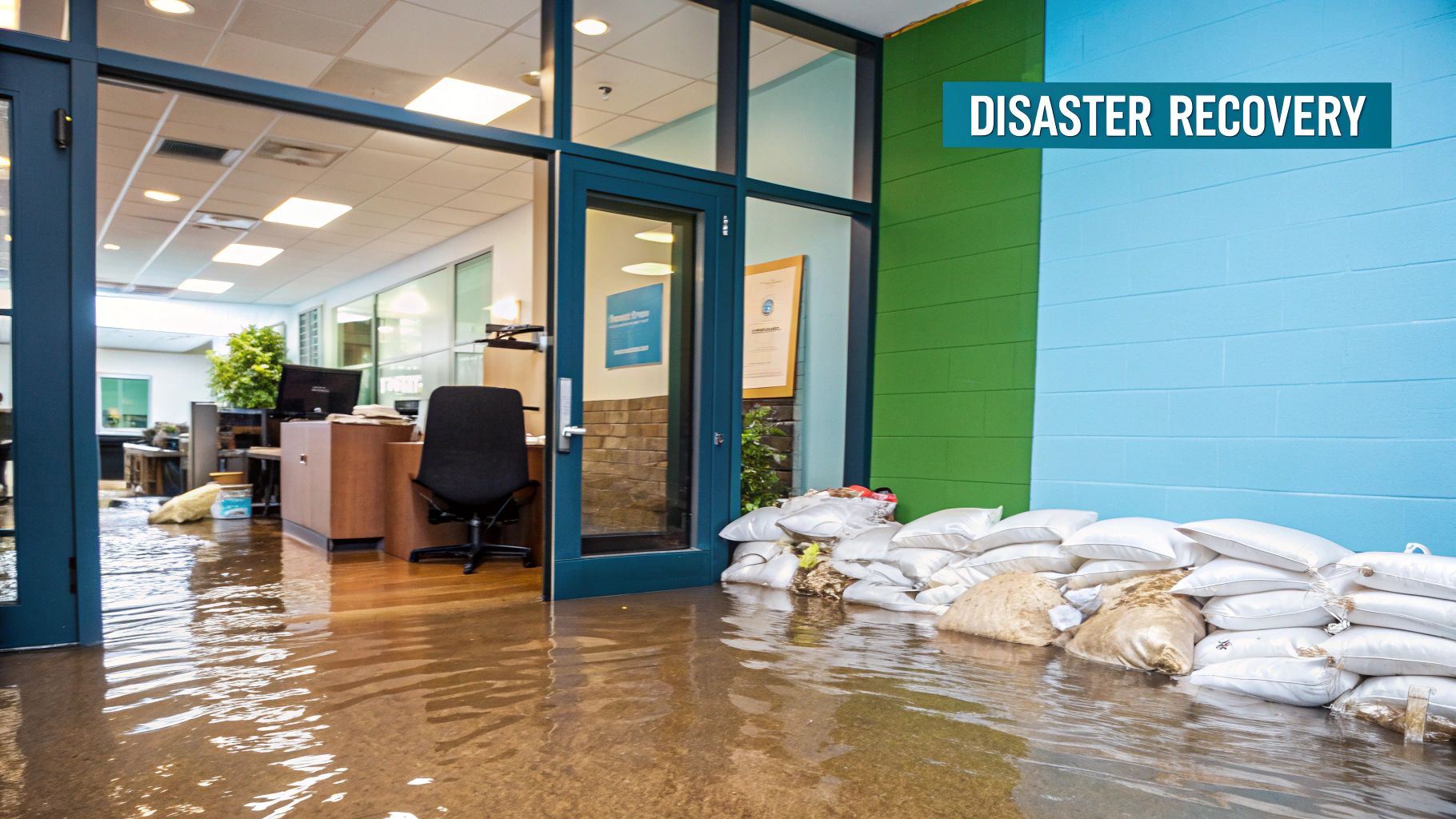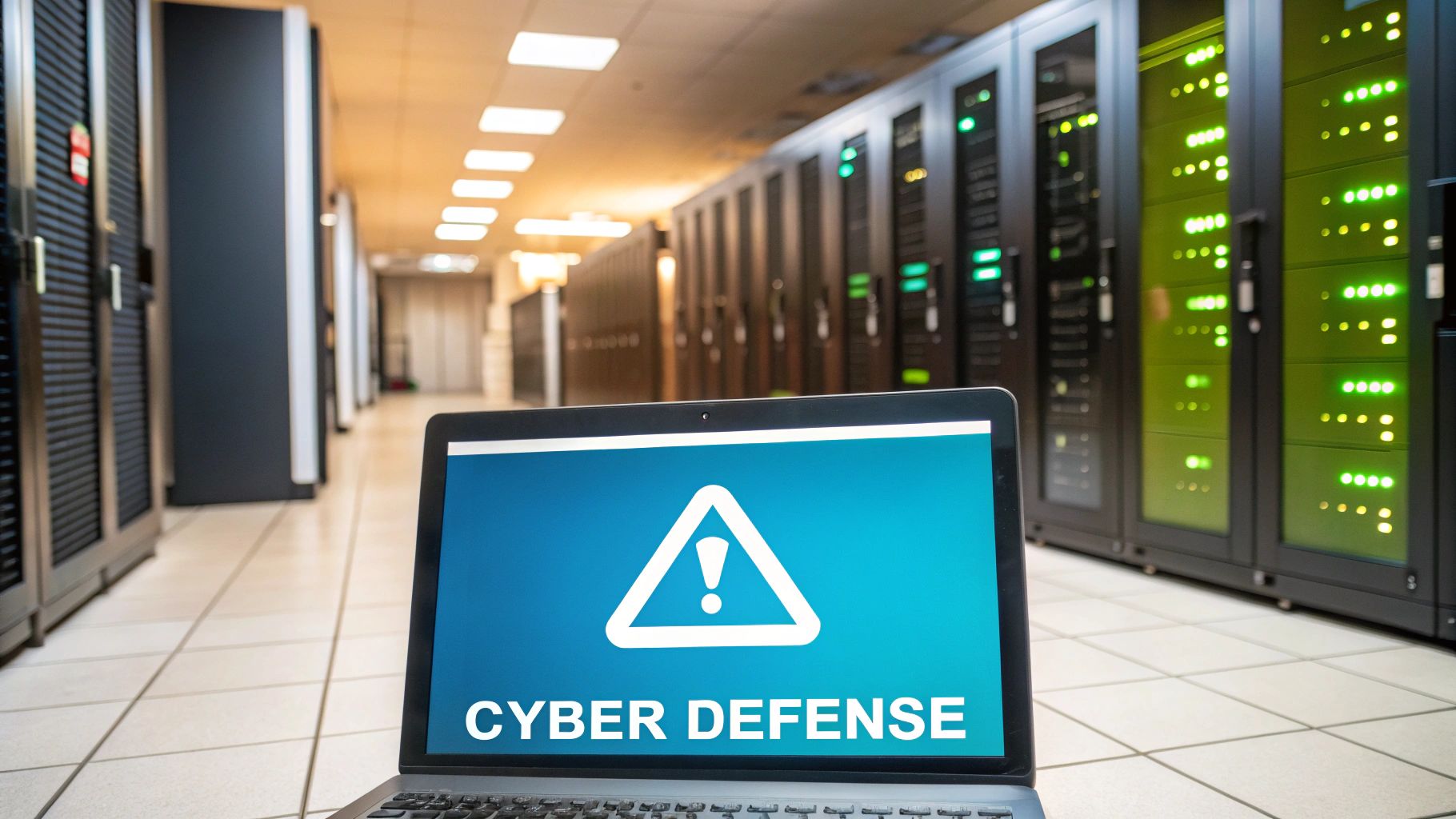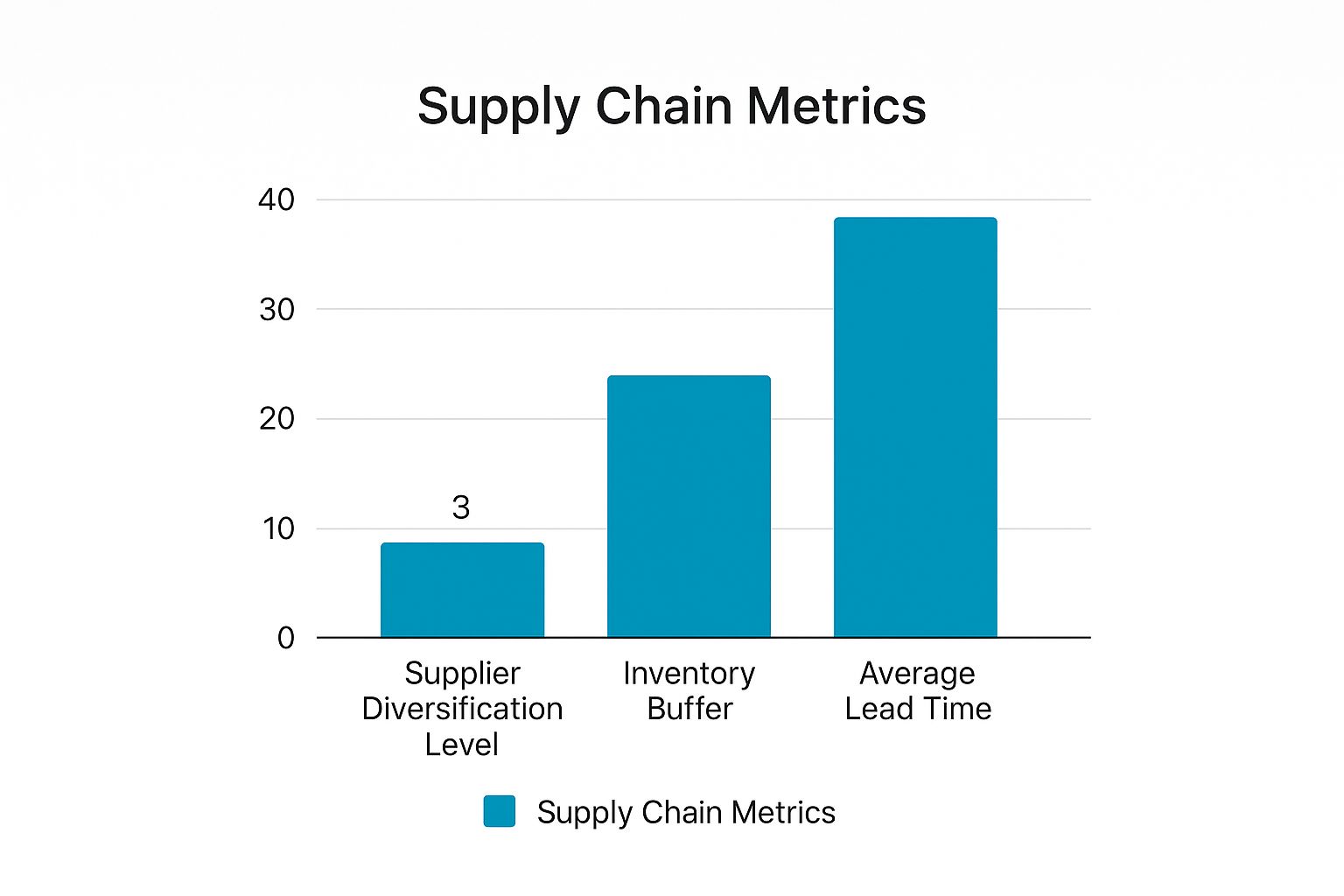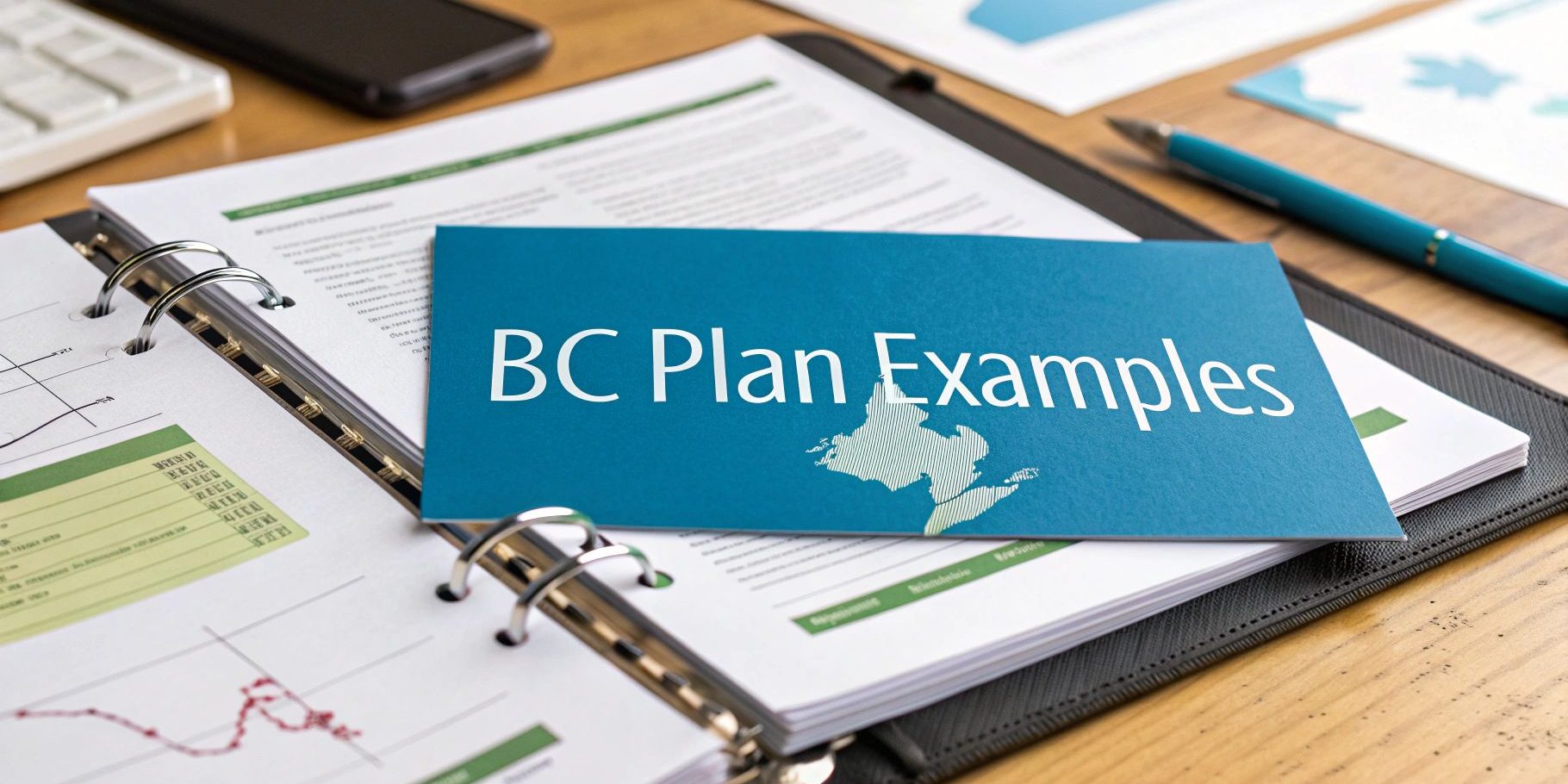In New Zealand, we’re no strangers to unexpected disruptions. From the seismic rumbles in Christchurch and Wellington to the global shocks of pandemics and cyber attacks, the question isn’t if your business will face a crisis, but when. A robust business continuity plan (BCP) is your organisation’s lifeline, a strategic document that ensures you can maintain essential functions and recover swiftly when disaster strikes. It’s the critical difference between weathering a storm and being washed away by it.
Many Kiwi small and medium-sized businesses (SMBs), including accounting firms, law practices, and marketing agencies, believe creating a BCP is too complex or expensive. This guide proves otherwise. We will break down seven distinct business continuity plan example frameworks, offering a practical, NZ-focused look at how to prepare for specific threats like natural disasters, IT failures, and supply chain interruptions.
We will analyse each example, providing actionable takeaways you can implement today to safeguard your operations, protect your data, and ensure your business endures. For complete peace of mind, a secure, automated backup solution is non-negotiable. Based in Christchurch, Backup offers nationwide backup and security for New Zealand businesses. Let’s explore how to build resilience into the core of your company.
1. Natural Disaster Recovery Plan
A Natural Disaster Recovery Plan is a critical component of business continuity, specifically designed to address disruptions from events like earthquakes, floods, and storms. Given New Zealand’s unique geography, particularly the seismic risks in areas like Wellington and Christchurch, having a robust plan is not just advisable; it’s essential for survival. This plan prioritises human safety, secures critical infrastructure, and outlines a clear path to resuming operations swiftly. It’s a proactive strategy rather than a reactive fix.

This type of plan is a cornerstone of any comprehensive business continuity plan example, as it tackles the most unpredictable yet potentially devastating threats. It requires a detailed understanding of regional risks and a commitment to regular testing and updates.
Strategic Breakdown
Japanese companies, for instance, have become global leaders in earthquake preparedness. Following the 2011 tsunami, many organisations refined their plans to include geographically dispersed data centres and strengthened supply chain redundancies. Similarly, Walmart’s lauded response to Hurricane Katrina showcased the power of empowering local managers with decision-making authority and pre-positioning essential supplies, ensuring they could support communities and employees while maintaining operations.
For a New Zealand SMB, this translates into having clear, pre-approved emergency protocols. The focus should be on enabling quick, decisive action without waiting for head-office approval, which can be a fatal delay during a crisis.
Actionable Takeaways for NZ Businesses
Kiwi businesses can implement these strategies to build resilience against natural disasters.
- Geographic Risk Assessment: Regularly analyse risks specific to your location. A business in Christchurch faces different primary threats (earthquakes) than one in Northland (cyclones, flooding).
- Establish Communication Channels: Don’t rely on a single method. Use a mix of SMS alerts, a private social media group, and a phone tree to ensure you can reach your team.
- Maintain “Go-Bags”: Keep emergency kits at the office containing first aid supplies, water, non-perishable food, torches, and a battery-powered radio.
- Secure Your Data Off-site: Your data is one of your most critical assets. A local server can be destroyed in a quake or flood. Utilising a New Zealand-based cloud backup service like Backup.co.nz ensures your vital information is securely stored in a separate geographical location, ready for recovery. You can explore our data protection plans and start with a 14-day free trial to see how it fits your needs.
- Partner Locally: Build relationships with neighbouring businesses and local civil defence authorities to coordinate response efforts.
Implementing a disaster recovery framework is fundamental. You can learn more about how a Natural Disaster Recovery Plan fits into your overall business continuity strategy.
2. Cybersecurity Incident Response Plan
A Cybersecurity Incident Response Plan is a specialised framework designed to prepare for, detect, contain, and recover from a digital attack. In an era where data breaches, ransomware, and system intrusions are increasingly common threats for New Zealand businesses, this plan is a non-negotiable part of modern business continuity. It provides a step-by-step guide to managing the aftermath of a security incident, focusing on minimising operational disruption, financial loss, and reputational damage.

This type of plan is a core element of any forward-thinking business continuity plan example, addressing the high-probability risk of cyber threats. It ensures a coordinated, calm, and effective response rather than a chaotic scramble when an attack occurs.
Strategic Breakdown
The global shipping giant Maersk’s recovery from the 2017 NotPetya ransomware attack serves as a powerful case study. The attack crippled their entire global network, but their survival was credited to a single server in Ghana being offline at the time, which contained a recent backup of their domain controller. This fluke highlighted the critical importance of offline, air-gapped backups. It forced a global rethink on cyber resilience, proving that even a massive organisation could be brought to its knees without a solid recovery strategy.
For a New Zealand SMB, the lesson is clear: your ability to recover is directly tied to the quality and accessibility of your backups. Relying solely on live, network-connected backups is a significant vulnerability in a ransomware scenario.
Actionable Takeaways for NZ Businesses
Kiwi businesses can take concrete steps to fortify their defences and prepare for a cyber incident.
- Implement Layered Security: Don’t rely on a single defence. Use a combination of firewalls, anti-malware software, email filtering, and multi-factor authentication (MFA) to create multiple barriers for attackers.
- Conduct Regular Vulnerability Scans: Proactively identify and patch weaknesses in your systems. Regular penetration testing and vulnerability assessments can uncover security gaps before criminals do.
- Establish Incident Response Playbooks: Create pre-defined action plans for common scenarios like a ransomware attack or a data breach. Outline who to contact, how to isolate affected systems, and when to engage legal counsel.
- Maintain Tested, Offline Backups: This is your ultimate safety net. Services like Backup.co.nz provide secure, off-site backups that are isolated from your primary network, ensuring your data is recoverable even if your live systems are compromised. You can see how our plans work with a 14-day free trial.
- Train Your Team: Your employees are your first line of defence. Conduct regular training on identifying phishing emails, using strong passwords, and reporting suspicious activity immediately.
A robust backup strategy is central to surviving a digital attack. You can learn more about how a robust backup solution helps fight against ransomware as part of your incident response plan.
3. Supply Chain Disruption Recovery Plan
A Supply Chain Disruption Recovery Plan is a business continuity strategy designed to maintain operations when disruptions like supplier failures, transport issues, or geopolitical events occur. For New Zealand, an island nation reliant on global trade, such a plan is paramount. It focuses on diversifying suppliers, managing inventory intelligently, and building logistical flexibility to ensure the continuous flow of goods and services. This plan moves a business from a vulnerable position to one of resilience and control.

This plan is an essential part of any modern business continuity plan example because it directly addresses the interconnected nature of today’s global economy. The bar chart above illustrates how balancing supplier diversification, inventory buffers, and lead times is key to building a resilient supply chain. A higher number of alternate suppliers and a healthy inventory buffer can effectively mitigate risks associated with longer lead times.
Strategic Breakdown
Toyota’s response to the 2011 Japanese tsunami is a masterclass in supply chain resilience. Having meticulously mapped their entire supply network, including sub-tier suppliers, they could quickly identify critical bottlenecks and work with alternative partners to resume production far faster than competitors. Similarly, Apple’s multi-sourcing strategy for key components like microchips allowed it to navigate the pandemic-induced shortages more effectively than many rivals.
For a New Zealand business, whether in manufacturing or retail, this means looking beyond your immediate supplier. Understanding who supplies your suppliers is crucial for identifying hidden risks that could halt your operations without warning.
Actionable Takeaways for NZ Businesses
Kiwi businesses can adopt these strategies to fortify their supply chains against global and local disruptions.
- Map Your Entire Supply Chain: Go beyond your primary suppliers. Identify their key suppliers (Tier 2) and even the ones before that (Tier 3) to understand your true dependencies.
- Diversify Critical Suppliers: Avoid relying on a single source for essential materials or components. Establish relationships with at least one alternative supplier, preferably in a different geographical region.
- Maintain Strategic Inventory: While “just-in-time” is efficient, “just-in-case” is resilient. Keep a strategic buffer of critical, long-lead-time items to weather short-term disruptions.
- Implement Supplier Monitoring: Use supplier scorecards that assess not just performance but also risk factors like financial stability, geopolitical location, and their own continuity plans.
- Establish Clear Communication Protocols: Ensure you have robust communication plans with your key suppliers to get early warnings of potential issues and coordinate responses effectively.
Building a resilient supply chain is a core element of a robust continuity strategy. You can find more detailed guidance in our business continuity plan template designed for NZ SMBs.
4. IT System Failure Recovery Plan
An IT System Failure Recovery Plan is a specialised framework designed to restore technology infrastructure after a disruption. This includes server crashes, network outages, or hardware malfunctions. In today’s digitally-driven economy, where even a momentary system failure can halt operations and erode customer trust, this plan is a non-negotiable part of business continuity. It ensures minimal downtime by employing redundant systems, robust backup procedures, and rapid restoration protocols.
For New Zealand businesses, especially those in professional services like law or accounting, data and system availability are paramount. A well-documented IT recovery plan is a core element of any strong business continuity plan example, protecting digital assets and maintaining operational integrity.
Strategic Breakdown
Global tech giants offer powerful lessons in IT resilience. Netflix, for example, famously uses a cloud-native, multi-region architecture on AWS. This means if one entire data centre region fails, its services seamlessly failover to another, an event that is largely invisible to its users. This highlights the power of distributed, redundant infrastructure over a single, centralised point of failure.
For a Kiwi SMB, this principle is accessible through cloud services. The strategy is not to build your own global network of data centres but to leverage providers who have. It’s about moving from disaster recovery to continuous availability, ensuring your systems are designed for failure, not just prepared for it.
Actionable Takeaways for NZ Businesses
NZ businesses can adopt these IT recovery strategies to protect their operations from technological disruptions.
- Define RTO and RPO: Establish your Recovery Time Objective (RTO) – how quickly you need systems back online – and Recovery Point Objective (RPO) – how much data you can afford to lose. These metrics will define your entire strategy.
- Automate and Test Backups: Manual backups are prone to human error. Use an automated system that backs up your data consistently. Regularly test your ability to restore from these backups to ensure they are viable.
- Embrace Cloud Redundancy: Utilising a New Zealand-based cloud service is the most effective way to achieve geographic redundancy. A Christchurch-based provider like Backup.co.nz stores your data securely away from your primary location, ensuring it’s safe from localised IT failures or disasters. You can test our service with a 14-day free trial to see how it integrates with your systems.
- Document Everything: Create detailed documentation for your IT infrastructure and recovery procedures. This “runbook” should be clear enough for another IT professional to execute the recovery without prior knowledge of your specific setup.
- Simulate Failures: Conduct regular disaster recovery drills where you simulate a system failure. These simulations will identify weaknesses in your plan and familiarise your team with their roles during a real crisis.
An IT System Failure Recovery Plan is essential for protecting your digital operations. Learn more about how to create a resilient IT framework as part of your overall continuity strategy.
5. Pandemic Response Plan
A Pandemic Response Plan is a specialised business continuity framework designed to manage disruptions from widespread public health crises. The COVID-19 pandemic demonstrated that such events require a unique approach, focusing on employee health, remote work capabilities, and adapting to government restrictions and dramatic shifts in customer behaviour. This plan is crucial for maintaining operations when physical presence is limited and supply chains are globally strained.

This plan is a vital part of any modern business continuity plan example, forcing businesses to prioritise flexibility, digital transformation, and clear communication. It’s about building resilience to a non-physical disaster that impacts every facet of the business, from personnel to procurement.
Strategic Breakdown
The global response to COVID-19 provided countless case studies. Shopify’s decisive move to a permanent remote-first model not only protected its workforce but also positioned it as a leader in the future of work, attracting global talent. Similarly, Zoom’s ability to rapidly scale its infrastructure to meet an unprecedented surge in demand showcased the importance of a flexible, cloud-based architecture. Their success was a direct result of having the systems in place to pivot and expand almost overnight.
For New Zealand businesses, the lesson is clear: operational agility is paramount. A plan that allows for a swift transition to remote work, supported by robust and secure technology, is no longer a luxury but a core business necessity. This involves pre-emptively solving challenges related to communication, data access, and team morale outside the traditional office environment.
Actionable Takeaways for NZ Businesses
Kiwi businesses can prepare for future health crises with these proactive strategies.
- Develop Robust Remote Work Policies: Formalise your work-from-home policy, including guidelines for technology use, security protocols, and performance expectations. Ensure every team member has the necessary equipment and access.
- Establish Clear Health and Safety Protocols: Following guidance from the Ministry of Health, create clear protocols for hygiene, health screenings, and managing unwell staff to protect your team and workplace.
- Cross-Train Your Team: Reduce dependency on key individuals by cross-training employees in critical roles. This ensures essential functions can continue even with significant staff absences.
- Secure Your Digital Workspace: A remote workforce is more vulnerable to cyber threats. A centralised, secure backup system is essential. With Backup.co.nz, you can ensure all business data, whether on-premise or from remote devices, is securely backed up in New Zealand, making it instantly recoverable. You can test our service with a 14-day free trial to safeguard your operations.
- Maintain Stakeholder Communication: Create a plan to regularly communicate with employees, clients, and suppliers. Transparency builds trust and helps manage expectations during uncertain times.
6. Key Personnel Loss Plan
A Key Personnel Loss Plan is a business continuity strategy focused on maintaining operations when critical employees are unavailable due to illness, departure, accidents, or other unforeseen circumstances. In New Zealand’s tight labour market, the unexpected loss of a key team member with specialised knowledge can halt projects, disrupt client relationships, and severely impact revenue. This plan is not about reacting to a departure; it’s about proactively building organisational resilience.
This plan is a vital part of any modern business continuity plan example because it addresses a highly probable risk that is often overlooked in favour of external threats. It ensures that knowledge isn’t siloed in one individual but is instead a shared, accessible asset.
Strategic Breakdown
Global giants like General Electric and Johnson & Johnson are renowned for their deep-rooted succession planning and leadership development programmes. They create a continuous pipeline of talent ready to step up. Similarly, Southwest Airlines famously uses cross-training to ensure employees can perform multiple roles, creating a flexible workforce that can adapt to sudden staff shortages.
For a Kiwi SME, this doesn’t mean building a multi-million-dollar corporate university. It means embedding knowledge sharing into the company culture. The goal is to make the business less dependent on any single individual, ensuring smooth operations even when a key person is suddenly out of the picture.
Actionable Takeaways for NZ Businesses
NZ businesses can implement these strategies to mitigate the risks of key personnel loss.
- Identify Critical Roles: Map out the roles that are indispensable to your daily operations. This isn’t just about leadership; it includes technical specialists or staff with unique client relationships.
- Implement Cross-Training: Schedule regular job-shadowing or rotation programmes. This not only prepares for absences but also increases employee engagement and skill sets.
- Document Everything: Create and maintain standard operating procedures (SOPs) for all critical tasks. Store this information in a centralised, secure, and accessible location, like a cloud-based knowledge management system.
- Build a Leadership Pipeline: A crucial part of mitigating the impact of key personnel loss is understanding how to approach creating a leadership succession plan. Start identifying and mentoring potential future leaders within your team now.
- Consider Key Person Insurance: For roles that are truly irreplaceable in the short term, key person insurance can provide a financial buffer to help the business cope with the financial impact of their loss.
7. Financial Crisis Recovery Plan
A Financial Crisis Recovery Plan is a specialised business continuity plan focused on navigating economic disruptions. These can range from internal cash flow shortages and credit crunches to external market downturns and full-blown recessions. This plan provides a strategic framework for financial resilience, prioritising cash flow management, immediate cost reductions, and transparent stakeholder communication to steer the business through turbulent times. It is a proactive defence of your company’s financial health.
This type of plan is a crucial business continuity plan example because financial viability underpins every other aspect of your operation. Without a plan to manage economic shocks, even a minor market shift can threaten a company’s existence. It demands rigorous financial foresight and a clear-eyed view of operational efficiencies.
Strategic Breakdown
During the 2008 global financial crisis, Ford Motor Company famously avoided a government bailout by implementing a drastic restructuring plan. They secured a massive line of credit before the crisis peaked, shed non-core brands, and focused on operational efficiency. This pre-emptive action allowed them to weather the storm while competitors struggled. Similarly, Starbucks responded to recessionary pressures by closing underperforming stores and streamlining its supply chain, focusing on core customer experience to maintain loyalty.
For a New Zealand SMB, the lesson is clear: financial preparedness requires decisive, pre-planned action. Waiting until cash reserves are depleted is too late. The strategy involves creating a tiered response plan that can be activated based on the severity of the financial trigger.
Actionable Takeaways for NZ Businesses
Kiwi businesses can build financial resilience by integrating these strategies into their continuity planning.
- Develop Tiered Cost-Reduction Plans: Create pre-defined plans for reducing operational costs at different levels of severity (e.g., 10%, 20%, 30% revenue drop). This could include freezing hiring, cutting discretionary spending, or renegotiating supplier contracts.
- Maintain Detailed Cash Flow Forecasts: Don’t just look at profit and loss; obsess over cash flow. Use forecasting tools to run various scenarios (e.g., “what if our largest client leaves?”) to understand your financial runway.
- Diversify Your Funding Sources: Relying on a single bank or investor is risky. Build relationships with multiple lenders and understand different funding options available in New Zealand, from traditional loans to government support schemes.
- Communicate with Stakeholders: Be transparent with your bank, key suppliers, and even your team about the financial situation and your plan to manage it. This builds trust and can open doors to more flexible payment terms or support.
- Protect Core Revenue and Data: Identify the core business functions and customer relationships that generate the most revenue and protect them at all costs. This includes safeguarding the operational data that drives your business. Utilising a secure, NZ-based cloud service like Backup.co.nz ensures your critical financial records, client data, and intellectual property are protected and recoverable, no matter the financial climate. You can secure your vital assets with a 14-day free trial to ensure your data is safe.
7 Business Continuity Plan Examples Compared
| Plan | Implementation Complexity | Resource Requirements | Expected Outcomes | Ideal Use Cases | Key Advantages |
|---|---|---|---|---|---|
| Natural Disaster Recovery Plan | High – involves emergency protocols, backup sites, drills | Significant investment in facilities, training, and supplies | Protects employees, maintains operations, enables rapid recovery | Businesses in disaster-prone areas across industries | Employee safety, faster recovery, insurance benefits |
| Cybersecurity Incident Response Plan | High – requires specialized expertise and evolving tech | Investment in security tools, skilled staff, training | Reduces downtime, preserves data and reputation, ensures compliance | Organizations facing cyber threats and regulation | Structured incident management, faster recovery |
| Supply Chain Disruption Recovery Plan | Medium to High – managing suppliers and logistics complexity | Resources for supplier diversification, inventory buffers | Continuous production, reduced supply risks, competitive reliability | Manufacturing, retail, industries reliant on suppliers | Risk reduction, supplier management, continuity |
| IT System Failure Recovery Plan | High – complex redundancy and backup systems | Significant IT infrastructure, cloud services, expert staff | Minimizes downtime, protects data, maintains customer service | Tech-reliant companies needing continuous IT operation | Reliability, data protection, rapid system restoration |
| Pandemic Response Plan | Medium – requires health protocols and remote work setup | Investment in technology, health measures, communication | Protects health, supports remote work, adapts operations | All sectors, especially during widespread health crises | Employee safety, operational flexibility, reputation |
| Key Personnel Loss Plan | Medium – focuses on training, succession, and staffing | Ongoing training, documentation, staffing solutions | Maintains operations during personnel gaps, develops talent | Organizations with critical roles and limited backups | Continuity of leadership, reduced dependency |
| Financial Crisis Recovery Plan | Medium – requires financial analysis and communication | Financial management tools, stakeholder engagement | Maintains operations, preserves stakeholder trust, enables recovery | Organizations facing economic downturns or cash flow issues | Risk mitigation, strategic planning, resilience |
Your Next Step: Building a Resilient Future for Your Business
Throughout this article, we have dissected several distinct business continuity plan examples, from natural disaster recovery to navigating a financial crisis. The core lesson from each scenario is consistent and clear: resilience is not an accident. It is the direct result of deliberate, proactive, and comprehensive planning. For any New Zealand small or medium-sized business, whether you are an accounting firm in Auckland or a law firm in Wellington, the templates and strategies provided serve as a robust foundation.
The journey from understanding these concepts to implementing a living, breathing plan can seem daunting. Your first step is to move from passive learning to active creation. Begin by identifying the most probable risks specific to your operations and location. A marketing agency in a high-rise might prioritise a different primary risk than a manufacturer with a complex supply chain. The key is to customise, not just copy.
From Examples to Action: Your Implementation Roadmap
Translating theory into practice requires a structured approach. The goal is to build a plan that is not only comprehensive but also practical and accessible when a crisis hits.
- Conduct a Business Impact Analysis (BIA): Before you can protect your operations, you must understand them. Identify your most critical business functions, the resources they depend on, and the maximum tolerable downtime for each. This analysis is the bedrock of your entire BCP.
- Assemble Your BCP Team: Designate clear roles and responsibilities. Your team should represent different departments to ensure all facets of the business are considered. This team will own the plan, from creation to testing and maintenance.
- Utilise a Structured Framework: Don’t try to reinvent the wheel. To streamline the development process and ensure all critical aspects are covered, consider utilising a comprehensive business continuity plan checklist. This can act as your guide, preventing critical oversights.
- Focus on the Data Foundation: The common thread in nearly every disaster scenario we’ve explored, be it a cybersecurity incident or an IT system failure, is the critical importance of data. Your ability to recover your client files, financial records, and operational data directly determines your ability to recover your business. This is why a secure, automated backup solution is a non-negotiable pillar of any modern business continuity plan example.
The Unwavering Importance of Data Protection
For New Zealand businesses, being prepared means having a plan that accounts for our unique environmental and digital landscapes. From our Christchurch base, we at Backup.co.nz understand this intimately. A solid BCP is incomplete without a guaranteed method to restore your digital assets. Our nationwide backup and security solutions are designed specifically for this purpose. We provide Kiwi businesses with peace of mind through simple, affordable plans:
- Business 10: $30 per month
- Business 20: $50 per month
- Business 50: $100 per month
- Business 100: $150 per month
Don’t let a crisis be the catalyst for action. The strongest businesses build their resilience during times of calm. Take the most crucial step in securing your operations by protecting your data today.
Your business continuity plan is only as strong as your ability to recover your data. Partner with local experts who understand the New Zealand landscape. Protect your most valuable asset with automated, secure, and reliable backups from Backup.co.nz. Start your free 14-day trial and solidify your business’s future resilience.







